The Scottish Diaspora Tapestry has received a most extraordinary and beautiful gift from tapestry stitchers in Iceland. Inspired by our 305 metre tapestry, which was exhibited in Eyjafjardazsveit, Nordland en route back from Canada in February 2017, stitchers all from Akureyri in Northern Iceland have created five Panels and donated them to us to be exhibited as may be possible in the years ahead – the first in Prestonpans. The Presentation takes place in the Scottish Parliament on June 3rd 2019 with many of those involved present. The 5 Panels are all drawn from The Book of Settlements and the tale behind each is given below.
Main Sponsors of the artwork were Helga Steinunn Gudmundsdottir, The Cultural Committee, Akureyri, Bryndis Simonardottir. Historical adviser on Aud the Deep and his sister Thorrun was Vilborg Davidsdottir.
The Panels were designed by Kristin Ragna Gunnarsdottir, an artist and art teacher at the Reykjarvik Art University; Bryndis Simonardottir, a handicraft artist and family therapist was the instigator and coordinator of the artwork.
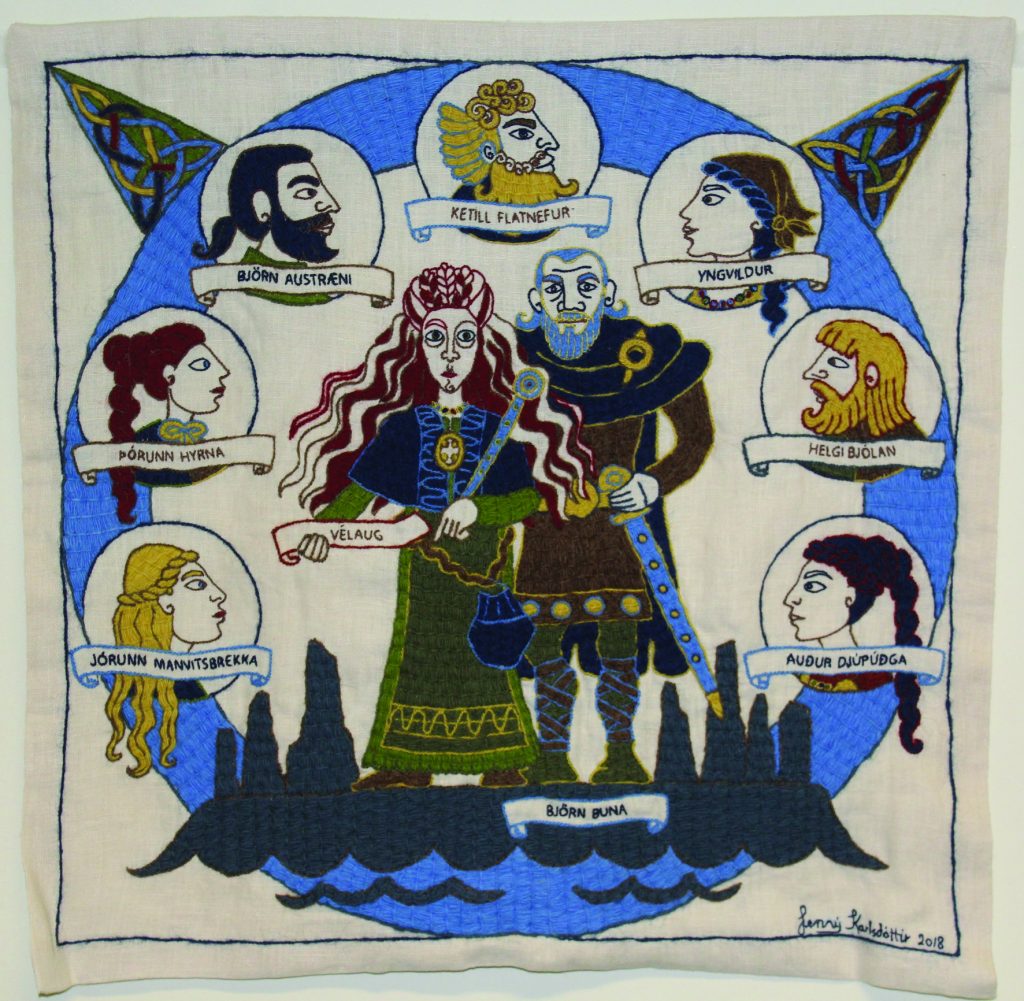
Pannal IS 01 Ketill the Flatnose a’ cìosachadh Innse Gall
Stitcher/Neach-Fuaigheil: Jenny Karlsdottir
A great chief named Björn buna [gush] lived in Sogn, Norway. Vélaug was his wife. Nearly all great families in Iceland descend from them. Their sons were Ketill Flatnose, Hrappur and Helgi. They were great men and many stories are told of their descendants in The Book of Settlements.
Ketill the Flatnose was married to Yngvildur, daughter of Ketill veður [Ram], chief in Ringerike in Norway. Their sons were Björn the Easterner and Helgi bjólan [Beólán]. Thórunn hyrna [of the Horn] was their daughter and she was married to Helgi the Lean, son of Eyvindur the Eastman and Rafarta [Rabhartach], daughter of Kjarval [Cerbal], king of the Irish. Audur the Deepminded was another daughter of Ketill and she was married to Ólafur the White, the greatest warrior king of the Western Seas. Ólafur conquered Dublin in Ireland and became king there. Jórunn manvitsbrekka [Mound of Wisdom], was also a daughter of Ketill.
Haraldur Fairhair, king in Norway, conquered the Hebrides but when he left, Vikings, Scots and Irishmen attacked the islands and raided far and wide. Haraldur then sent Ketill the Flatnose to win back the islands. Ketill went west but left his son Björn in Norway. He re-subjugated all the Hebrides and became chief there, refusing to pay the tribute due to the king in Norway. Haraldur then seized all Ketill’s land in Norway and drove out his son. Later, Björn the Easterner came to the Western Isles and then settled in Iceland, like his siblings. He was married to Gjaflaug, daughter of Kjallakur [Cellach].
(Retold from the Saga of the People of Laxárdalur, The Book of Settlements and The Saga of the People of Eyri.)

Björn buna hét hersir ágætur í Sogni í Noregi. Hann átti Vélaugu. Frá þeim er nær allt stórmenni komið á Íslandi. Þau áttu synina Ketil flatnef, Hrapp og Helga. Þeir voru ágætir menn og er frá afkvæmi þeirra margt sagt í Landnámabók.
Ketill flatnefur átti Yngvildi, dóttur Ketils veðurs, hersis í Hringaríki. Synir þeirra voru Björn austræni og Helgi bjólan. Þórunn hyrna hét dóttir Ketils er átti Helgi hinn magri, son Eyvindar austmanns og Raförtu, dóttur Kjarvals Írakonungs. Auður djúpúðga var enn dóttir Ketils er átti Ólafur hvíti er þá var mestur herkonungur fyrir vestan haf. Ólafur vann Dyflinni á Írlandi og gerðist þar konungur yfir. Jórunn manvitsbrekka var einnig dóttir Ketils.
Haraldur hárfagri, konungur í Noregi, lagði undir sig allar Suðureyjar en er hann fór þaðan réðust víkingar, Skotar og Írar á eyjarnar og herjuðu og rændu víða. Haraldur sendi þá Ketil flatnef að vinna aftur eyjarnar. Ketill fór vestur um haf en setti eftir í Noregi Björn son sinn. Hann lagði undir sig allar Suðureyjar og gerðist höfðingi yfir en galt konungi enga skatta sem ætlað var. Tók þá konungur undir sig eignir hans í Noregi og rak á brott Björn son hans. Björn austræni kom síðar til Suðureyja og fór þaðan til Íslands líkt og systkin hans. Hann átti Gjaflaugu Kjallaksdóttur.
(Endursagt úr Laxdæla sögu, Landnámabók og Eyrbyggja sögu.)
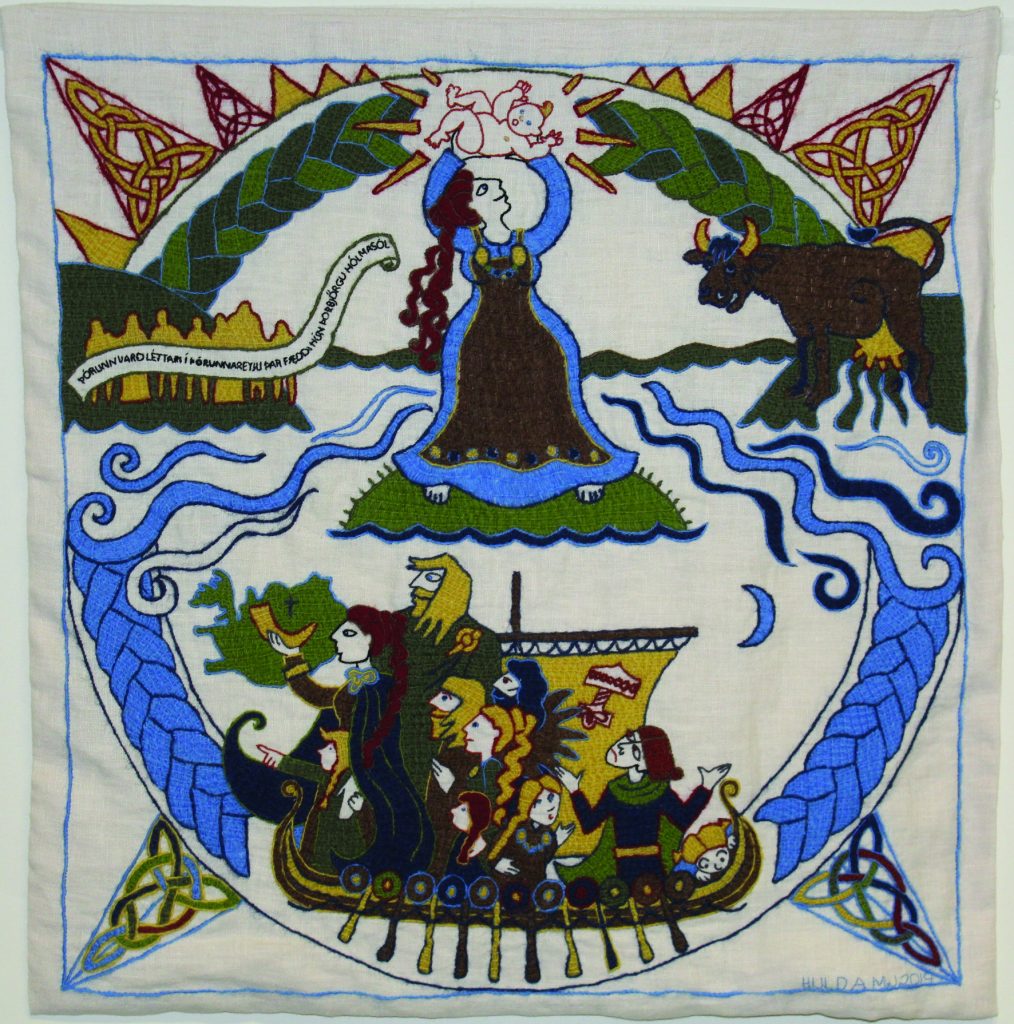
Pannal IS 02 Helgi the Lean a’ fàgail Innse Gall ’s a’ dol gu Innis Tìle
Stitcher/Neach-Fuaigheil: Hulda M Jonsdottir
Helgi the Lean was the son of Eyvindur the Easterner and Rafarta [Rabhartach], daughter of Kjarval [Cerbal], king of the Irish. He was sent to be fostered in the Hebrides when he was young. He married Thórunn, daughter of Ketill the Flatnose.
They went to Iceland with their children Ingunn, Hrólfur, Ingjaldur, Helga, Hlíf, Thórhildur and Thóra. With them came also their son-in-law, Hámundur heljarskinn [Dark-Skinned], who was married to Ingunn. Helgi was very shifty in his faith. He believed in Christ, but made vows to Thor for sea-faring and hardy deeds. When Helgi sighted Iceland, he inquired of Thor where he should make land and the oracle directed him northward round the land. Hrólfur, his son, then asked whether Helgi must hold into Dumbshaf [lit. Foggy Sea] if Thor should direct him thither, as the crew thought that now it was high time to leave the sea, because the summer was in a great measure spent.
Helgi settled the whole of Eyjafjördur between Siglunes og Reynisnes and made a great fire at every river mouth and thus hallowed to himself the whole district. He wintered at Bíldsá River but in the spring, he moved to Kristnes [Christ’s Ness]. During the move of his household Thórunn gave birth on Thórunn’s Holm in Eyjarfjardará River, to Thorbjörg Hólmasól [Sun-of-the-Holm]. Helgi believed in Christ and therefore gave his name to his dwelling.
(Retold from The Book of Settlements.)

Helgi hinn magri hét sonur Eyvindar austmanns og Raförtu, dóttur Kjarvals Írakonungs. Þau settu hann til fósturs í Suðureyjum í æsku. Hann fékk Þórunnar hyrnu, dóttur Ketils flatnefs.
Þau fóru til Íslands með börn sín. Það voru Ingunn, Hrólfur, Ingjaldur, Helga, Hlíf, Þórhildur og Þóra. Með þeim fór Hámundur heljarskinn er átti Ingunni. Helgi var blandinn mjög í trú. Hann trúði á Krist en hét á Þór til sjófara og harðræða. Er Helgi sá Ísland gekk hann til frétta við Þór hvar land skyldi taka en fréttin vísaði honum norður um landið. Þá spurði Hrólfur son hans hvort Helgi mundi halda í Dumbshaf ef Þór vísaði honum þangað því að skipverjum þótti mál úr hafi er áliðið var mjög sumarið.
Helgi nam allan Eyjafjörð milli Sigluness og Reynisness og gerði eld mikinn við hvern vatnsós og helgaði sér svo allt hérað. Hann sat þann vetur að Bíldsá en færði bú sitt í Kristsnes um vorið. Í búfærslunni varð Þórunn léttari í Þórunnareyju í Eyjafjarðará. Þar fæddi hún Þorbjörgu hólmasól. Helgi trúði á Krist og kenndi því við hann bústað sinn.
(Endursagt úr Landnámabók.)
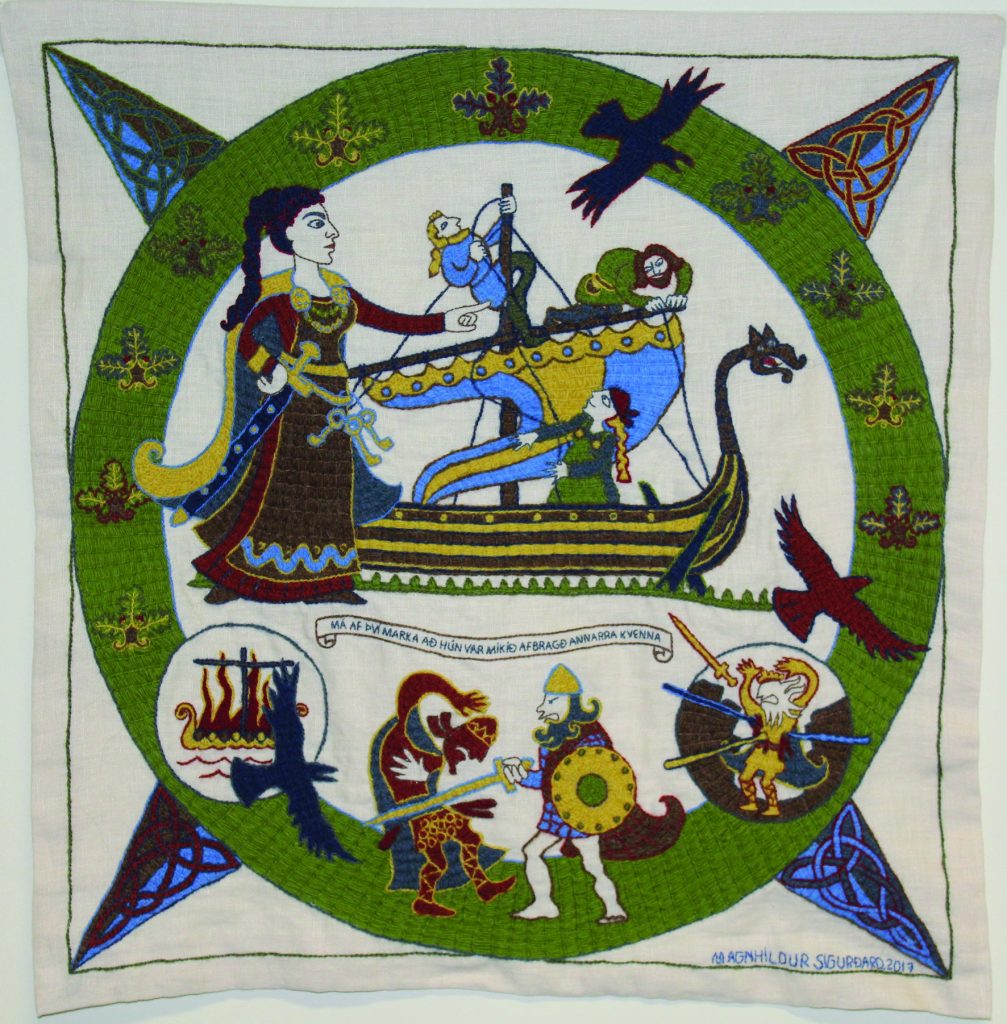
Pannal IS 03 Thornsteinn the Red a’ bàsachadh sa bhlàr agus Ardur a’ fàgail Gallaibh
Stitcher/Neach-Fuaigheil: Magnhildur Sigurdardottir
Thorsteinn the Red was the son of Audur the Deepminded and Ólafur the White. He married Thurídur, sister of Helgi the Lean. Their daughters were Gróa, Ólöf, Thorgerdur, Ósk, Thórhildur and Vigdís and their son was Ólafur feilan [Fáelán].
After his father was killed, Thorsteinn became a warrior king. He allied himself with Sigurdur ríki [the Mighty], Earl of the Orkneys. They won for themselves Caithness and Sutherland, Ross and Moray and more than half of Scotland. Thorsteinn became a king over these lands but the Scots betrayed him and he was killed in battle in Caithness.
Audur was in Caithness when she heard about her son‘s death. And when she heard that Thorsteinn had died, she deemed she would have no prospering in store there. So, she had a ship built secretly in the woods. And when it was ready built she arrayed it, and had great wealth withal. She took with her all her kinsfolk who were left alive and men deem that scarce may an example be found that any woman has ever got out of such a state of war with so much wealth and such a large retinue. From this it may be seen what a great paragon of women she was.
(Retold from The Book of Settlements and The Saga of the People of Laxárdalur.)

Sonur Auðar djúpúðgu og Ólafs hvíta var Þorsteinn rauður. Hann fékk Þuríðar, systur Helga hins magra. Dætur þeirra voru Gróa, Ólöf, Þorgerður, Ósk, Þórhildur og Vigdís en sonur þeirra Ólafur feilan.
Þorsteinn gerðist herkonungur eftir fall föður síns. Hann réðst til félags með Sigurði jarli hinum ríka í Orkneyjum. Þeir unnu Katanes og Suðurland, Ros og Merrhæfi og meir en hálft Skotland. Gerðist Þorsteinn þar konungur yfir áður Skotar sviku hann og féll hann í orrustu á Katanesi.
Auður var þá á Katanesi er hún spurði fall Þorsteins. Og er hún fregnaði að Þorsteinn var látinn en faðir hennar andaður þá þóttist hún þar enga uppreist fá mundu. Eftir það lætur hún gera knörr í skógi á laun. Og er skipið var algert þá bjó hún það og hafði auð fjár. Hún hafði í brott með sér allt frændlið sitt það er á lífi var og þykjast menn varla dæmi til vita að einn kvenmaður hafi komist í brott úr þvílíkum ófriði með jafnmiklu fé og föruneyti. Má af því marka að hún var mikið afbragð annarra kvenna.
(Endursagt úr Landnámabók og Laxdæla sögu)
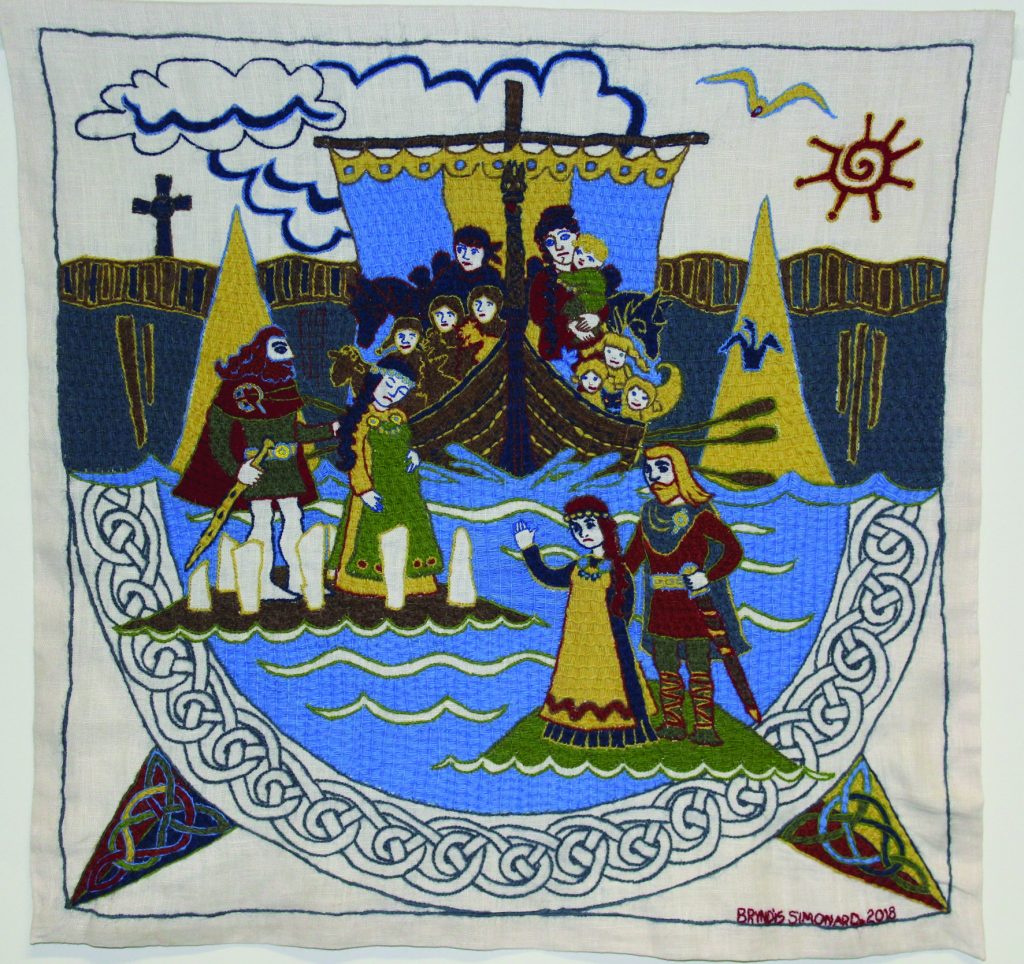
Pannal IS 04 Ardur a’ siubhal a’ dh’Arcaibh, na h-Eileanan Fàrach agus long-bhriste an Innis Tìle
Stitcher/ Neach-Fuaigheil: Bryndis Simonardottir
Audur the Deepminded went to the Orkney Islands and there she gave away in marriage her granddaughter Gróa, daughter of Thorsteinn the Red, to Dungaður [Donnchadh/Duncan], Earl of Caithness. Groa was the mother of Grélöd [Gléflaith], wife of Thorfinnur Skull-Splitter, Earl of Orkney and from them descend all the earls of Orkney.
Erpur [Pictish: Erp] was a freedman of Audur’s, son of Meldún [Máel-Dúin], earl of Scotland, who was killed by Earl Sigurdur of Orkney. Erpur’s mother was Myrgjol [Muirgeal], daughter of Gljómall [Gléomál], king of the Irish. Sigurdur took them captive in war and made them suffer. Myrgjol was a servant to the earl’s lady. Audur bought her for a high price and promised her freedom if she would serve Thuridur, wife of Thorsteinn the Red, as she had become the queen. Myrgjol and Erpur then went to Iceland with Audur.
Next, she sailed her ship to the Faroe Islands and there, she gave Ólöf, daughter of Thorsteinn, in marriage. From there, the most noble family of that land is descended, called the Götuskeggjar [People of Gata in the isle of Eysturoy]. Now, Audur left the Faroe Islands, heading to Iceland. She came ashore at Vikrarskeid in the South and was shipwrecked there. All her men were saved, and her goods also.
She then went to Kjalarnes, to her brother Helgi bjólan [beólán] with 20 men. He offered her to stay with ten of them but she felt this was ungenerous, stating that his was always an ignoble character. She then went to Breidafjordur, to her brother Björn. He invited her to lodge with him with all her retinue, which she accepted.
(Retold from The Saga of Eiríkur the Red, The Saga of St. Ólafur, The Book of Settlements, The Saga of the People of the Faroe Islands and The Saga of the People of Laxárdalur.)

Auður djúpúðga hélt út í Orkneyjar og gifti þar Gróu, dóttur Þorsteins rauðs, Dungaði jarli af Katanesi. Hún var móðir Grélaðar er átti Þorfinnur hausakljúfur Orkneyjajarl. Er þaðan komið kyn allra Orkneyingajarla.
Erpur hét leysingi Auðar, son Meldúns jarls af Skotlandi er féll fyrir Sigurði Orkneyjajarli. Móðir Erps var Myrgjol, dóttir Gljómals Írakonungs. Sigurður jarl tók þau að herfangi og þjáði. Myrgjol var ambátt konu jarls og var margkunnandi. Auður keypti hana dýrt og hét henni frelsi ef hún þjónaði svo Þuríði, konu Þorsteins rauðs, sem drottningu. Myrgjol og Erpur fóru til Íslands með Auði.
Hún hélt skipi sínu næst til Færeyja og gifti þar Ólöfu, dóttur Þorsteins. Þaðan er komin sú ætt er ágætust er í því landi er þeir kalla Götuskeggja. Nú býst Auður í brott úr Færeyjum og heldur til Íslands. Hún kom skipi sínu fyrir sunnan land á Vikrarskeið og braut þar. Menn allir héldust og svo fé.
Hún fór þá á Kjalarnes til Helga bjólan bróður síns með tuttugu menn. Hann bauð henni þar með helming liðs síns en henni þótti það varboðið og kvað hann lengi mundu lítilmenni vera. Hún fór þá vestur í Breiðafjörð til Bjarnar bróður síns. Hann bauð henni þar með alla sína menn og þáði hún það.
(Endursagt úr Eiríks sögu rauða, Ólafs sögu helga, Landnámabók, Færeyinga sögu og Laxdæla sögu.)
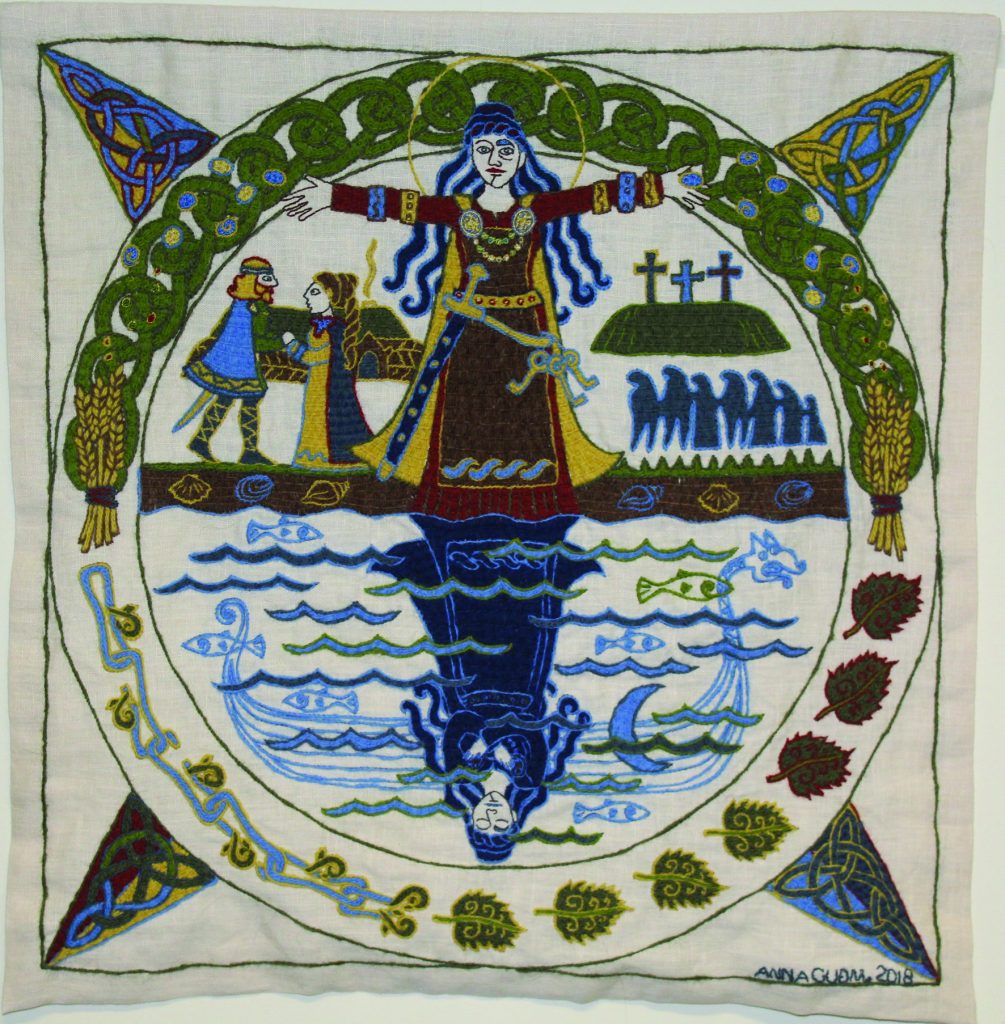
Pannal IS 05 Audur the Deepminded a’ gabhail fois eadar muir-làn is muir-tràghaidh
Stitcher/Neach-Fuaigheil: Anna Gudmundsdottir
In the spring, Audur went exploring the lands of Breidafjordur in the west of Iceland and took for herself all the lands of the Dales on the inner side of Hvammsfjordur. She lived at Hvammur and said her prayers at Krosshólar [Hills of the Cross]. There she had crosses raised as she was baptised and deeply religious.
Audur gave land to her crew and freedmen, for many who came with her were noble men taken captive by Vikings, raiding in the Western Seas, and enslaved. To Kollur, son of Vedrar-Grímur, she gave Thorgerdur Thorsteinn’s daughter as wife, and with her all Laxárdale. To Ketill, she gave land from River Skraumuhlaupsá to River Hördadalsá and to Hördur Hördadale.
Audur freed her slaves and gave them land. Vífill got Vífilsdale and Sökkólfur Sökkólfsdale. To her Scottish slave, Hundi [Lit. Dog, perhaps from Gael. Cú], she gave Hundadale. To Erp, son of Earl Meldún and Myrgjol, Audur gave the lands of Saudafell. From him, the Erplings are descended. She gave Ósk, daughter of Thorsteinn the Red, to Hallstein godi [chief’s title] and Thorhildur to Eysteinn meinfretur [Ill-Fart], son of Álfur. She gave Vigdís Thorsteinn’s daughter to Kampa [Moustache]-Grímur. From them are descended the Höfdi-Men of Eyjafjordur.
Audur fostered Ólafur, son of Thorsteinn. He was a great man and very strong, handsome in looks and of great abilities. His wife was Álfdís, of the Barra Isles, daughter of Konáll [Conall].
Audur the Deepminded was a very stately woman. When she was weary with old age, she invited all her kinsmen to a splendid feast. After three nights, she bestowed gifts on her friends and gave them counsel, saying that the feast should stand for three nights more and that should be her funeral feast. She died the night after and was buried on the shore, between high and low water mark, as she had herself ordered, for she would not lie in unhallowed ground, being baptised.
(Retold from The Book of Settlements, The Saga of the People of Laxárdalur and The Saga of Eiríkur the Red.)

Um vorið fór Auður í landaleit inn í Breiðafjörð og nam öll Dalalönd í innanverðum Hvammsfirði. Hún bjó í Hvammi og hafði bænahald sitt á Krosshólum. Þar lét hún reisa krossa því að hún var skírð og vel trúuð.
Auður gaf land skipverjum sínum og leysingjum en með henni komu margir göfugir menn er herteknir höfðu verið í vesturvíking og voru ánauðugir. Kollur Veðrar-Grímsson fékk Þorgerðar Þorsteinsdóttur og lét Auður fylgja henni Laxárdal allan. Katli gaf hún land frá Skraumuhlaupsá til Hörðadalsár og Herði Hörðadal.
Auður gaf þrælum sínum frelsi og lönd: Vífli Vífilsdal og Sökkólfi Sökkólfsdal. Hundi hét leysingi hennar skoskur. Honum gaf hún Hundadal. Erpi, syni Meldúns jarls og Myrgjolar, gaf Auður Sauðafellslönd. Frá honum eru Erplingar komnir. Ósk, dóttur Þorsteins rauðs, gaf Auður Hallsteini goða og Þórhildi Eysteini meinfret Álfssyni. Vigdísi Þorsteinsdóttur gaf hún Kampa-Grími. Þaðan eru komnir Höfðamenn í Eyjafirði.
Auður fóstraði Ólaf feilan, son Þorsteins. Hann var mikill maður og sterkur, fríður sýnum og atgervimaður hinn mesti. Hann fékk Álfdísar hinnar barreysku, Konálsdóttur.
Auður djúpúðga var vegskona mikil. Þá er hún var ellimóð bauð hún til sín frændum sínum og mágum í dýrlega veislu. Eftir þrjár nætur valdi hún vinum sínum gjafir, réð þeim heilræði og sagði að þá skyldi standa veislan enn þrjár nætur; það skyldi vera erfi sitt. Nóttina eftir andaðist hún og var grafin í flæðarmáli sem hún hafði fyrir sagt því að hún vildi eigi liggja í óvígðri moldu, er hún var skírð.
(Endursagt úr Landnámabók, Laxdæla sögu og Eiríks sögu rauða.)
